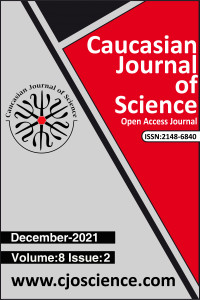Investigation of The Activity of Lipase Variants on Different 4-Nitrophenyl Esters by Spectrophotometric Assay
Abstract
Microbial enzymes are important tools that are frequently used in the field of biotechnology. These microbial enzymes, which play a role in intracellular biological reactions, are used in many different industries. Lipase, proteases and amylases are important members of hydrolytic enzymes. Lipase enzyme, which has the most common usage area among hydrolytic enzymes, is an enzyme that catalyzes the hydrolysis of ester bonds between lipid molecules. The activity of lipase enzyme is commonly measured by spectrophotometric method. P-nitrophenol esters are commonly preferred for kinetic analysis. In the spectrophotometric analysis method, the colored product is measured as a result of the hydrolysis of p-nitrophenol ester substrates by the lipase enzyme. In this study, p-nitrophenyl acetate (Acetic acid 4-nitrophenyl ester), p-nitrophenyl butyrate (Butyric acid 4-nitrophenyl ester), p-nitrophenyl octanoate (Octanoic acid 4-nitrophenyl ester, 4 -Nitrophenyl caprylate), p-nitrophenyl dodecanoate (Dodecanoic acid 4-nitrophenyl ester), p-nitrophenyl palmitate (p-Nitrophenyl palmitate, Hexadecanoic acid 4-nitrophenyl ester) substrates were used. The products formed as a result of incubation of substrates with different carbon lengths with lipase enzyme periods were measured spectrophotometrically. Trials were carried out at 25°C between 5min-120min. As a result of the experiments carried out in four repetitions, it was determined that the activity of the lipase enzyme varies according to the length of the carbon chain of the substrates. Vmax values of wild lipase enzyme were calculated as 0.42 U/mg protein, 0.95 U/mg protein, 1.1 U/mg protein, 0.78 U/mg protein, 0.18 U/mg protein for pNP-acetate, pNP-buritate, pNP-octanoate, pNP-dodecanoate, pNP-palmitate, respectively. It was determined that the activity of lipase enzyme on p-nitrophenyl palmitate was very low. It was determined that the activity of wild lipase enzyme on the eight-carbon chain pNP-octanoate substrate was higher than the other substrates.
Supporting Institution
Altınbaş University Scientific Research Fund
Project Number
PB2020-SHMYO-4
References
- Bloom, J. D., & Arnold, F. H. (2009). In the light of directed evolution: pathways of adaptive protein evolution. Proceedings of the National Academy of Sciences, 106(Supplement 1), 9995-10000. https://doi.org/10.1073/pnas.0901522106
- Bornscheuer, U. T., & Pohl, M. (2001). Improved biocatalysts by directed evolution and rational protein design. Current opinion in chemical biology, 5(2), 137-143. https://doi.org/10.1016/S1367-5931(00)00182-4
- Bornscheuer, U., & Kazlauskas, R. J. (2011). Survey of protein engineering strategies. Current protocols in protein science, 66(1), 26-7. https://doi.org/10.1002/0471140864.ps2607s66
- Bornscheuer, U. T., Huisman, G. W., Kazlauskas, R. J., Lutz, S., Moore, J. C., & Robins, K. (2012). Engineering the third wave of biocatalysis. Nature, 485(7397), 185-194. https://doi.org/10.1038/nature11117
- Böttcher, D., & Bornscheuer, U. T. (2010). Protein engineering of microbial enzymes. Current opinion in microbiology, 13(3), 274-282. https://doi.org/10.1016/j.mib.2010.01.010
- Califano, V., Ausanio, G., Bloisi, F., Aronne, A., Vicari, L. R., & Nasti, L. (2015). m-DOPA addition in MAPLE immobilization of lipase for biosensor applications. Sensing and bio-sensing research, 6, 103-108. https://doi.org/10.1016/j.sbsr.2015.07.007
- Ciuffreda, P., Casati, S., Loseto, A., & Santaniello, E. (2009). Spectrophotometric Assay of Lipase Activity: A New 4-nitrophenyl Ester of a Dialkylglycerol Suitable as a Chromogenic Substrate of Pseudomonas cepacia Lipase. Biocatalysis and Biotransformation, 21(3), 123-127. https://doi.org/10.1080/1024242031000155055
- Denard, C. A., Ren, H., & Zhao, H. (2015). Improving and repurposing biocatalysts via directed evolution. Current opinion in chemical biology, 25, 55-64. https://doi.org/10.1016/j.cbpa.2014.12.036
- Deng, L., Xu, X., Haraldsson, G. G., Tan, T., & Wang, F. (2005). Enzymatic production of alkyl esters through alcoholysis: A critical evaluation of lipases and alcohols. Journal of the American Oil Chemists' Society, 82(5), 341-347. https://doi.org/10.1007/s11746-005-1076-3
- Dror, A., Shemesh, E., Dayan, N., & Fishman, A. (2014). Protein engineering by random mutagenesis and structure-guided consensus of Geobacillus stearothermophilus lipase T6 for enhanced stability in methanol. Applied and environmental microbiology, 80(4), 1515-1527. https://doi.org/10.1128/AEM.03371-13
- Goldsmith, M., & Tawfik, D. S. (2012). Directed enzyme evolution: beyond the low-hanging fruit. Current opinion in structural biology, 22(4), 406-412. https://doi.org/10.1016/j.sbi.2012.03.010
- Hasan, F., Shah, A. A., & Hameed, A. (2006). Industrial applications of microbial lipases. Enzyme and Microbial technology, 39(2), 235-251. https://doi.org/10.1016/j.enzmictec.2005.10.016
- Hwang, H. T., Qi, F., Yuan, C., Zhao, X., Ramkrishna, D., Liu, D., & Varma, A. (2014). Lipase‐catalyzed process for biodiesel production: Protein engineering and lipase production. Biotechnology and bioengineering, 111(4), 639-653. https://doi.org/10.1002/bit.25162
- Jaeger, K. E., & Reetz, M. T. (1998). Microbial lipases form versatile tools for biotechnology. Trends in biotechnology, 16(9), 396-403. https://doi.org/10.1016/S0167-7799(98)01195-0
- Jaeger, K. E., & Eggert, T. (2002). Lipases for biotechnology. Current opinion in biotechnology, 13(4), 390-397. https://doi.org/10.1016/S0958-1669(02)00341-5
- Kimtun, P., Choonut, O., Yunu, T., Paichid, N., Klomkloa, S., & Sangkharak, K. (2015). Biodiesel production using lipase from oil palm fruit as a catalyst. Energy Procedia, 79, 822-826. https://doi.org/10.1016/j.egypro.2015.11.572
- Maharana, A., & Ray, P. (2015). A novel cold-active lipase from psychrotolerant Pseudomonas sp. AKM-L5 showed organic solvent resistant and suitable for detergent formulation. Journal of Molecular Catalysis B: Enzymatic, 120, 173-178. https://doi.org/10.1016/j.molcatb.2015.07.005
- Mala, J. G. S., Kamini, N. R., & Puvanakrishnan, R. (2001). Strain improvement of Aspergillus niger for enhanced lipase production. The Journal of general and applied microbiology, 47(4), 181-186. https://doi.org/10.2323/jgam.47.181
- Mosmuller, E. W. J., Van Heemst, J. D. H., Van Delden, C. J., Franssen, M. C. R., & Engbersen, J. F. J. (2009). A New Spectrophotometric Method for the Detection of Lipase Activity Using 2,4-Dinitrophenyl Butyrate as a Substrate, Biocatalysis, 5(4), 279-287. https://doi.org/10.3109/10242429209014874
- Noro, J., Castro, T.G., Cavaco-Paulo, A., & Silva, C. (2020). Substrate hydrophobicity and enzyme modifiers play a major role in the activity of lipase from Thermomyces lanuginosus. Catalysis Science & Technology, 17(10), 5913-5924. https://doi.org/10.1039/D0CY00912A
- Özarslaner, E., & Albayrak, N. (2013). Lipaz aktivitesinin spektrofotometrik yöntemle belirlenmesinde çevresel koşulların p-nitrofenil propiyonat substratının kararlığına etkisi. Gıda / The Journal of Food, 38(3), 143-149. https://dergipark.org.tr/tr/pub/gida/issue/6951/92706
- Patkar, S., Vind, J., Kelstrup, E., Christensen, M. W., Svendsen, A., Borch, K., & Kirk, O. (1998). Effect of mutations in Candida antarctica B lipase. Chemistry and physics of lipids, 93(1-2), 95-101. https://doi.org/10.1016/S0009-3084(98)00032-2
- Pencreac'h, G., & Baratti, J.C. (1996). Hydrolysis of p-nitrophenyl palmitate in n-heptane by the Pseudomonas cepacia lipase: A simple test for the determination of lipase activity in organic media. Enzyme and Microbial Technology, 18(6), 417-422. https://doi.org/10.1016/0141-0229(95)00120-4
- Rigoldi, F., Donini, S., Redaelli, A., Parisini, E., & Gautieri, A. (2018). Review: Engineering of thermostable enzymes for industrial applications. APL Bioengineering, 2(1), 011501. https://doi.org/10.1063/1.4997367
- Rotticci, D., Rotticci‐Mulder, J. C., Denman, S., Norin, T., & Hult, K. (2001). Improved enantioselectivity of a lipase by rational protein engineering. ChemBioChem, 2(10), 766-770. https://doi.org/10.1002/1439-7633(20011001)2:10<766::AID-CBIC766>3.0.CO;2-K
- Rubingh, D. N. (1997). Protein engineering from a bioindustrial point of view. Current opinion in biotechnology, 8(4), 417-422. https://doi.org/10.1016/S0958-1669(97)80062-6
- Ruslan, R., Rahman, R. N. Z. R. A., Leow, T. C., Ali, M. S. M., Basri, M., & Salleh, A. B. (2012). Improvement of thermal stability via outer-loop ion pair interaction of mutated T1 lipase from Geobacillus zalihae strain T1. International Journal of Molecular Sciences, 13(1), 943-960. https://doi.org/10.3390/ijms13010943
- Šibalić, D., Šalić, A., Zelić, B., Nam Tran, N., Hessel, V., & Tišma, M. (2020). A New Spectrophotometric Assay for Measuring the Hydrolytic Activity of Lipase from Thermomyces lanuginosus: A Kinetic Modeling. ACS Sustainable Chem. Eng., 8(12), 4818–4826. https://doi.org/10.1021/acssuschemeng.9b07543
- Smeltzer, M.S., Hart, M.E., & Iandolo, J.J. (1992). Quantitative spectrophotometric assay for staphylococcal lipase. Appl Environ Microbiol., 58(9), 2815-9. https://doi.org/10.1128/aem.58.9.2815-2819.1992
- Tunçsoy, B., Sugeçti, S., Büyükgüzel, E., Özalp, P., & Büyükgüzel, K. (2021). Effects of Copper Oxide Nanoparticles on Immune and Metabolic Parameters of Galleria mellonella L. Bulletin of Environmental Contamination and Toxicology, 1-9. https://doi.org/10.1007/s00128-021-03261-0
- Widersten, M. (2014). Protein engineering for development of new hydrolytic biocatalysts. Current opinion in chemical biology, 21, 42-47. https://doi.org/10.1016/j.cbpa.2014.03.015
Abstract
Project Number
PB2020-SHMYO-4
References
- Bloom, J. D., & Arnold, F. H. (2009). In the light of directed evolution: pathways of adaptive protein evolution. Proceedings of the National Academy of Sciences, 106(Supplement 1), 9995-10000. https://doi.org/10.1073/pnas.0901522106
- Bornscheuer, U. T., & Pohl, M. (2001). Improved biocatalysts by directed evolution and rational protein design. Current opinion in chemical biology, 5(2), 137-143. https://doi.org/10.1016/S1367-5931(00)00182-4
- Bornscheuer, U., & Kazlauskas, R. J. (2011). Survey of protein engineering strategies. Current protocols in protein science, 66(1), 26-7. https://doi.org/10.1002/0471140864.ps2607s66
- Bornscheuer, U. T., Huisman, G. W., Kazlauskas, R. J., Lutz, S., Moore, J. C., & Robins, K. (2012). Engineering the third wave of biocatalysis. Nature, 485(7397), 185-194. https://doi.org/10.1038/nature11117
- Böttcher, D., & Bornscheuer, U. T. (2010). Protein engineering of microbial enzymes. Current opinion in microbiology, 13(3), 274-282. https://doi.org/10.1016/j.mib.2010.01.010
- Califano, V., Ausanio, G., Bloisi, F., Aronne, A., Vicari, L. R., & Nasti, L. (2015). m-DOPA addition in MAPLE immobilization of lipase for biosensor applications. Sensing and bio-sensing research, 6, 103-108. https://doi.org/10.1016/j.sbsr.2015.07.007
- Ciuffreda, P., Casati, S., Loseto, A., & Santaniello, E. (2009). Spectrophotometric Assay of Lipase Activity: A New 4-nitrophenyl Ester of a Dialkylglycerol Suitable as a Chromogenic Substrate of Pseudomonas cepacia Lipase. Biocatalysis and Biotransformation, 21(3), 123-127. https://doi.org/10.1080/1024242031000155055
- Denard, C. A., Ren, H., & Zhao, H. (2015). Improving and repurposing biocatalysts via directed evolution. Current opinion in chemical biology, 25, 55-64. https://doi.org/10.1016/j.cbpa.2014.12.036
- Deng, L., Xu, X., Haraldsson, G. G., Tan, T., & Wang, F. (2005). Enzymatic production of alkyl esters through alcoholysis: A critical evaluation of lipases and alcohols. Journal of the American Oil Chemists' Society, 82(5), 341-347. https://doi.org/10.1007/s11746-005-1076-3
- Dror, A., Shemesh, E., Dayan, N., & Fishman, A. (2014). Protein engineering by random mutagenesis and structure-guided consensus of Geobacillus stearothermophilus lipase T6 for enhanced stability in methanol. Applied and environmental microbiology, 80(4), 1515-1527. https://doi.org/10.1128/AEM.03371-13
- Goldsmith, M., & Tawfik, D. S. (2012). Directed enzyme evolution: beyond the low-hanging fruit. Current opinion in structural biology, 22(4), 406-412. https://doi.org/10.1016/j.sbi.2012.03.010
- Hasan, F., Shah, A. A., & Hameed, A. (2006). Industrial applications of microbial lipases. Enzyme and Microbial technology, 39(2), 235-251. https://doi.org/10.1016/j.enzmictec.2005.10.016
- Hwang, H. T., Qi, F., Yuan, C., Zhao, X., Ramkrishna, D., Liu, D., & Varma, A. (2014). Lipase‐catalyzed process for biodiesel production: Protein engineering and lipase production. Biotechnology and bioengineering, 111(4), 639-653. https://doi.org/10.1002/bit.25162
- Jaeger, K. E., & Reetz, M. T. (1998). Microbial lipases form versatile tools for biotechnology. Trends in biotechnology, 16(9), 396-403. https://doi.org/10.1016/S0167-7799(98)01195-0
- Jaeger, K. E., & Eggert, T. (2002). Lipases for biotechnology. Current opinion in biotechnology, 13(4), 390-397. https://doi.org/10.1016/S0958-1669(02)00341-5
- Kimtun, P., Choonut, O., Yunu, T., Paichid, N., Klomkloa, S., & Sangkharak, K. (2015). Biodiesel production using lipase from oil palm fruit as a catalyst. Energy Procedia, 79, 822-826. https://doi.org/10.1016/j.egypro.2015.11.572
- Maharana, A., & Ray, P. (2015). A novel cold-active lipase from psychrotolerant Pseudomonas sp. AKM-L5 showed organic solvent resistant and suitable for detergent formulation. Journal of Molecular Catalysis B: Enzymatic, 120, 173-178. https://doi.org/10.1016/j.molcatb.2015.07.005
- Mala, J. G. S., Kamini, N. R., & Puvanakrishnan, R. (2001). Strain improvement of Aspergillus niger for enhanced lipase production. The Journal of general and applied microbiology, 47(4), 181-186. https://doi.org/10.2323/jgam.47.181
- Mosmuller, E. W. J., Van Heemst, J. D. H., Van Delden, C. J., Franssen, M. C. R., & Engbersen, J. F. J. (2009). A New Spectrophotometric Method for the Detection of Lipase Activity Using 2,4-Dinitrophenyl Butyrate as a Substrate, Biocatalysis, 5(4), 279-287. https://doi.org/10.3109/10242429209014874
- Noro, J., Castro, T.G., Cavaco-Paulo, A., & Silva, C. (2020). Substrate hydrophobicity and enzyme modifiers play a major role in the activity of lipase from Thermomyces lanuginosus. Catalysis Science & Technology, 17(10), 5913-5924. https://doi.org/10.1039/D0CY00912A
- Özarslaner, E., & Albayrak, N. (2013). Lipaz aktivitesinin spektrofotometrik yöntemle belirlenmesinde çevresel koşulların p-nitrofenil propiyonat substratının kararlığına etkisi. Gıda / The Journal of Food, 38(3), 143-149. https://dergipark.org.tr/tr/pub/gida/issue/6951/92706
- Patkar, S., Vind, J., Kelstrup, E., Christensen, M. W., Svendsen, A., Borch, K., & Kirk, O. (1998). Effect of mutations in Candida antarctica B lipase. Chemistry and physics of lipids, 93(1-2), 95-101. https://doi.org/10.1016/S0009-3084(98)00032-2
- Pencreac'h, G., & Baratti, J.C. (1996). Hydrolysis of p-nitrophenyl palmitate in n-heptane by the Pseudomonas cepacia lipase: A simple test for the determination of lipase activity in organic media. Enzyme and Microbial Technology, 18(6), 417-422. https://doi.org/10.1016/0141-0229(95)00120-4
- Rigoldi, F., Donini, S., Redaelli, A., Parisini, E., & Gautieri, A. (2018). Review: Engineering of thermostable enzymes for industrial applications. APL Bioengineering, 2(1), 011501. https://doi.org/10.1063/1.4997367
- Rotticci, D., Rotticci‐Mulder, J. C., Denman, S., Norin, T., & Hult, K. (2001). Improved enantioselectivity of a lipase by rational protein engineering. ChemBioChem, 2(10), 766-770. https://doi.org/10.1002/1439-7633(20011001)2:10<766::AID-CBIC766>3.0.CO;2-K
- Rubingh, D. N. (1997). Protein engineering from a bioindustrial point of view. Current opinion in biotechnology, 8(4), 417-422. https://doi.org/10.1016/S0958-1669(97)80062-6
- Ruslan, R., Rahman, R. N. Z. R. A., Leow, T. C., Ali, M. S. M., Basri, M., & Salleh, A. B. (2012). Improvement of thermal stability via outer-loop ion pair interaction of mutated T1 lipase from Geobacillus zalihae strain T1. International Journal of Molecular Sciences, 13(1), 943-960. https://doi.org/10.3390/ijms13010943
- Šibalić, D., Šalić, A., Zelić, B., Nam Tran, N., Hessel, V., & Tišma, M. (2020). A New Spectrophotometric Assay for Measuring the Hydrolytic Activity of Lipase from Thermomyces lanuginosus: A Kinetic Modeling. ACS Sustainable Chem. Eng., 8(12), 4818–4826. https://doi.org/10.1021/acssuschemeng.9b07543
- Smeltzer, M.S., Hart, M.E., & Iandolo, J.J. (1992). Quantitative spectrophotometric assay for staphylococcal lipase. Appl Environ Microbiol., 58(9), 2815-9. https://doi.org/10.1128/aem.58.9.2815-2819.1992
- Tunçsoy, B., Sugeçti, S., Büyükgüzel, E., Özalp, P., & Büyükgüzel, K. (2021). Effects of Copper Oxide Nanoparticles on Immune and Metabolic Parameters of Galleria mellonella L. Bulletin of Environmental Contamination and Toxicology, 1-9. https://doi.org/10.1007/s00128-021-03261-0
- Widersten, M. (2014). Protein engineering for development of new hydrolytic biocatalysts. Current opinion in chemical biology, 21, 42-47. https://doi.org/10.1016/j.cbpa.2014.03.015
Details
| Primary Language | English |
|---|---|
| Subjects | Environmental Sciences |
| Journal Section | Caucasian Journal of Science |
| Authors | |
| Project Number | PB2020-SHMYO-4 |
| Publication Date | December 31, 2021 |
| Submission Date | July 9, 2021 |
| Acceptance Date | December 2, 2021 |
| Published in Issue | Year 2021 Volume: 8 Issue: 2 |
Cited By
Production and Activity Characterization of Lipase from Bacillus flexus InaCC-B486
Journal of the Turkish Chemical Society Section A: Chemistry
https://doi.org/10.18596/jotcsa.1333916








